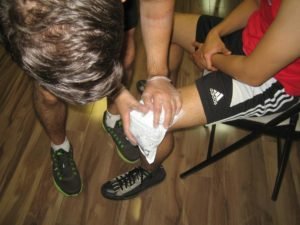Many find it confusing on whether to apply cold therapy or hot therapy after an individual sustained an injury whether at work or sports. Always remember that the answer depends on the type of injury sustained.
Acute injuries
It is important to note that acute injuries are those that occur after traumatic events such as a fall, direct blow or twisting movement and these injuries are usually painful.
Once an individual sustained an acute injury, the inflammation, bleeding, swelling and pain must be controlled. An ice pack should be applied as soon as possible to cool the tissues, slow down their metabolic rate and nerve conduction velocity. The ice will also cause vasoconstriction of the surrounding blood vessels in the area.
The ice pack must be allowed to stay in contact with the injured area for up to 20 minutes at a time depending on the size of the area being treated and the depth of the damaged tissues. Make sure that the ice pack is reapplied on a regular basis, usually every 1-3 hours.

After 3-5 days after sustaining an acute injury when the bleeding has stopped and there are no indications of inflammation, it is recommended to alternate cold and heat treatments. You can apply an ice pack for 10 minutes and then followed by 10 minutes of heat. This alternating technique will cause a significant increase in the blood flow to the area as the vasoconstriction caused by the cooling reverses once heat is applied, resulting to an influx of blood to the damaged tissues. Make sure that the bleeding is controlled before applying this method. Remember that blood is vital in providing energy and essential nutrient needed for the body for repair.
Chronic injuries
When it comes to chronic injuries, they do not have an abrupt onset. These injuries tend to build up gradually over a period of days, weeks or longer and often caused by biomechanical abnormality or overuse. Take note that a chronic injury can also be caused by an acute injury that did not heal properly due to incorrect treatment.
Heat therapy must be applied for 15-20 minutes using a warm damp towel, hot water bottle, heat rub or commercially-available heating pads. If a hot water bottle is used, make sure that a layer of protection is placed over the skin to prevent burns.
Generally, heat must be used in managing chronic injuries in order to relax tight, aching joints and muscles as well as increase the elasticity of the tendons and ligaments and even increasing the flow of blood to the area. Remember that heat therapy can also be used before exercise in chronic injuries to warm up the muscles and increase the flexibility. The only time when ice can be used on chronic injuries is after exercises to reduce any residual swelling.
